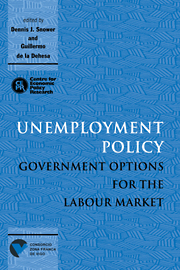Book contents
- Frontmatter
- Contents
- List of figures
- List of tables
- Preface
- Acknowledgements
- List of conference participants
- 1 Introduction
- PART ONE GENERAL POLICY ISSUES
- PART TWO DEMAND MANAGEMENT AND SUPPLY-SIDE POLICY
- PART THREE SUBSIDISING EMPLOYMENT AND TRAINING
- PART FOUR LABOUR MARKET REGULATIONS
- PART FIVE POLICY, JOB REALLOCATION AND THE UNEMPLOYMENT–PRODUCTIVITY RELATION
- 14 Is there a trade-off between unemployment and productivity growth?
- Discussion
- 15 Gross job reallocation and labour market policy
- Discussion
- Discussion
- PART SIX COMPARING UNEMPLOYMENT POLICIES
- Index
Discussion
Published online by Cambridge University Press: 07 September 2010
- Frontmatter
- Contents
- List of figures
- List of tables
- Preface
- Acknowledgements
- List of conference participants
- 1 Introduction
- PART ONE GENERAL POLICY ISSUES
- PART TWO DEMAND MANAGEMENT AND SUPPLY-SIDE POLICY
- PART THREE SUBSIDISING EMPLOYMENT AND TRAINING
- PART FOUR LABOUR MARKET REGULATIONS
- PART FIVE POLICY, JOB REALLOCATION AND THE UNEMPLOYMENT–PRODUCTIVITY RELATION
- 14 Is there a trade-off between unemployment and productivity growth?
- Discussion
- 15 Gross job reallocation and labour market policy
- Discussion
- Discussion
- PART SIX COMPARING UNEMPLOYMENT POLICIES
- Index
Summary
The relationship between gross job reallocation and labour market variables is an important one, that both theory and empirical work must address. Chapter 15 by Garibaldi, Konings and Pissarides represents a first stab at the empirical side. In this Discussion, I begin with a consideration of the relevance of cross-country differences in gross job reallocation. I then discuss the comparability of the data for the 10 countries considered and finally assess the validity of the empirical results presented in the chapter.
Do cross-country variations in gross job reallocation tell us anything?
At first glance, the gross job reallocation rates reported in chapter 15 would surprise most labour economists. If it is supposed that high levels of reallocation signify a flexible labour market, then apparently Sweden and France have some of the most flexible labour markets in the OECD, and even Italy has broadly similar results to the USA. This suggests that such a simple interpretation cannot be given to reallocation rates.
The authors acknowledge that there are ‘no strong theoretical reasons for supposing that more job reallocation is better than less’. Indeed, the only reason suggested for favouring high levels of job reallocation is that it appears to be negatively correlated with long-term unemployment. In light of this the authors suggest that ‘policy measures that restrict job reallocation will have negative impact on the functioning of labour markets’. Surely, however, policy makers are likely to be interested in more general measures of economic welfare.
- Type
- Chapter
- Information
- Unemployment PolicyGovernment Options for the Labour Market, pp. 489 - 495Publisher: Cambridge University PressPrint publication year: 1997
- 6
- Cited by



